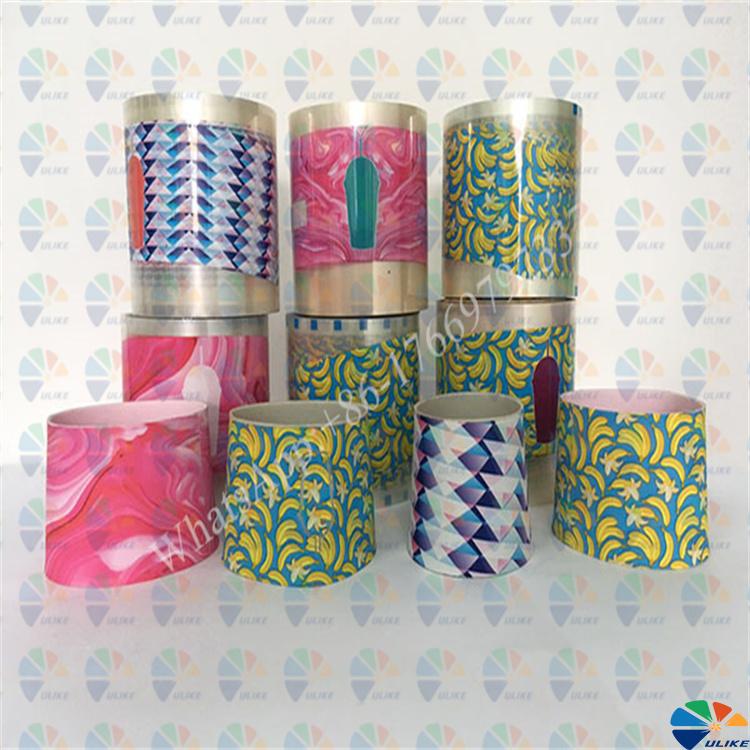Detailed explanation of thermal transfer base film
Detailed explanation of thermal transfer base film
Common thermal transfer base films include films made of materials such as PET and OPP, among which PET film is the most common type of thermal transfer base film. Next, we will focus on some basic theories of PET film as a thermal transfer base film.
1. Introduction to base film
Photo of
thermal transfer base film
PET film is also known as high-temperature resistant polyester film. It has excellent physical properties, chemical properties, dimensional stability, transparency, and recyclability. When PET film is used to make thermal transfer base film, it uses the characteristics of high tensile strength, good thermal stability, low thermal shrinkage, smooth surface, and good peelability of PET film to achieve the production of thermal transfer film and ensure its stable quality.
The thermal transfer base film is a medium material of the thermal transfer process, which plays a connecting role in the entire thermal transfer process. The post-process of thermal transfer is to heat and pressurize the thermal transfer base film once by the thermal transfer machine, and transfer the decorative pattern on the thermal transfer base film to the surface of the substrate to form a high-quality finishing pattern.
2. Thermal transfer base film usage parameters
The thermal transfer base film has its own unique properties. In order to obtain the ideal hot stamping effect, the optimal temperature, pressure and speed must be strictly controlled to match the process characteristics of the thermal transfer base film. It has three strict process parameter indicators:
1. Determination of temperature:
When the temperature is too low, the pattern will not be firmly hot stamped; when the temperature is too high, the ink layer of the pattern will oxidize on the surface, causing the pattern to lose its proper gloss, the color to darken, and in severe cases, bubbles will form.
To determine the optimal hot stamping temperature, the following factors should be considered: pressure, speed, area, room temperature and other factors.
The hot stamping temperature generally ranges from 140℃ to 260℃ depending on the material of the substrate. Once the optimal temperature is determined, the temperature of the hot stamping machine should be kept constant, and the temperature difference should be controlled within ±2℃ as much as possible.
2. Determination of pressure:
The hot stamping pressure is generally 4-6 kg/cm2.
If the pressure is too low, the thermal transfer film cannot form a close contact with the substrate, reducing the adhesion of the pattern; if the pressure is too high, the substrate will be deformed under pressure, affecting the overall printing effect of the substrate.
If the hot stamping surface is not flat enough, you should also pay attention to the uniformity of each pressure point, and the pressure angle between the silicone roller and the substrate should be higher, otherwise, it is very easy to have uneven adhesion of the substrate pattern.
3. Determination of speed:
This is determined according to the hot stamping area of the substrate, and the power of the heating system of the thermal transfer machine should be considered.
The order of temperature, pressure and speed is: speed first, pressure second, and temperature last.
3. Precautions for base film storage
Thermal transfer base film products should be stored as follows:
A. Handle with care, and only store vertically and not horizontally;
B. At the same time, it cannot be stored near heat sources to avoid melting of the adhesive on the back of the thermal transfer film due to high temperature, so it must be kept away from heat sources, and it is generally better to store it at 25℃;
C. Prevent moisture. Once it is damp, it should be dried in time, otherwise it will produce gas during use, which will affect its use effect.

![af]() Afrikaans
Afrikaans![sq]() Albanian
Albanian![am]() Amharic
Amharic![ar]() Arabic
Arabic![fr]() French
French![es]() Spanish
Spanish![ru]() Russian
Russian![de]() German
German![hy]() Armenian
Armenian![it]() Italian
Italian![ja]() Japanese
Japanese![ko]() Korean
Korean![pt]() Portuguese
Portuguese![hi]() Hindi
Hindi![az]() Azerbaijani
Azerbaijani![ro]() Romanian
Romanian![pl]() Polish
Polish![th]() Thai
Thai![el]() Greek
Greek![eu]() Basque
Basque![en]() English
English![zh-CN]() Chinese (Simplified)
Chinese (Simplified)![zh-TW]() Chinese (Traditional)
Chinese (Traditional)![be]() Belarusian
Belarusian![bn]() Bengali
Bengali![bs]() Bosnian
Bosnian![bg]() Bulgarian
Bulgarian![ca]() Catalan
Catalan![ceb]() Cebuano
Cebuano![ny]() Chichewa
Chichewa![co]() Corsican
Corsican![hr]() Croatian
Croatian![cs]() Czech
Czech![da]() Danish
Danish![nl]() Dutch
Dutch![eo]() Esperanto
Esperanto![et]() Estonian
Estonian![tl]() Filipino
Filipino![fi]() Finnish
Finnish![fy]() Frisian
Frisian![gl]() Galician
Galician![ka]() Georgian
Georgian![gu]() Gujarati
Gujarati![ht]() Haitian Creole
Haitian Creole![ha]() Hausa
Hausa![haw]() Hawaiian
Hawaiian![iw]() Hebrew
Hebrew![hmn]() Hmong
Hmong![hu]() Hungarian
Hungarian![is]() Icelandic
Icelandic![ig]() Igbo
Igbo![id]() Indonesian
Indonesian![ga]() Irish
Irish![jw]() Javanese
Javanese![kn]() Kannada
Kannada![kk]() Kazakh
Kazakh![km]() Khmer
Khmer![ku]() Kurdish (Kurmanji)
Kurdish (Kurmanji)![ky]() Kyrgyz
Kyrgyz![lo]() Lao
Lao![la]() Latin
Latin![lv]() Latvian
Latvian![lt]() Lithuanian
Lithuanian![lb]() Luxembourgish
Luxembourgish![mk]() Macedonian
Macedonian![mg]() Malagasy
Malagasy![ms]() Malay
Malay![ml]() Malayalam
Malayalam![mt]() Maltese
Maltese![mi]() Maori
Maori![mr]() Marathi
Marathi![mn]() Mongolian
Mongolian![my]() Myanmar (Burmese)
Myanmar (Burmese)![ne]() Nepali
Nepali![no]() Norwegian
Norwegian![ps]() Pashto
Pashto![fa]() Persian
Persian![pa]() Punjabi
Punjabi![sm]() Samoan
Samoan![gd]() Scottish Gaelic
Scottish Gaelic![sr]() Serbian
Serbian![st]() Sesotho
Sesotho![sn]() Shona
Shona![sd]() Sindhi
Sindhi![si]() Sinhala
Sinhala![sk]() Slovak
Slovak![sl]() Slovenian
Slovenian![so]() Somali
Somali![su]() Sudanese
Sudanese![sw]() Swahili
Swahili![sv]() Swedish
Swedish![tg]() Tajik
Tajik![ta]() Tamil
Tamil![te]() Telugu
Telugu![tr]() Turkish
Turkish![uk]() Ukrainian
Ukrainian![ur]() Urdu
Urdu![uz]() Uzbek
Uzbek![vi]() Vietnamese
Vietnamese![cy]() Welsh
Welsh![xh]() Xhosa
Xhosa![yi]() Yiddish
Yiddish![yo]() Yoruba
Yoruba![zu]() Zulu
Zulu


